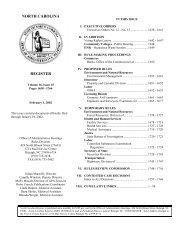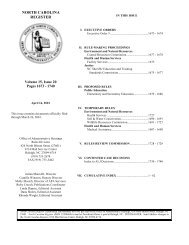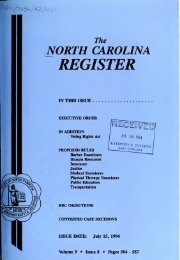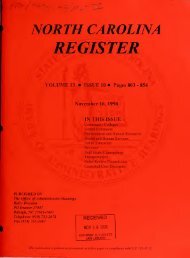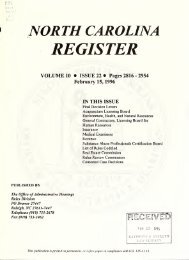NC Register Volume 21 Issue 09 - Office of Administrative Hearings
NC Register Volume 21 Issue 09 - Office of Administrative Hearings
NC Register Volume 21 Issue 09 - Office of Administrative Hearings
You also want an ePaper? Increase the reach of your titles
YUMPU automatically turns print PDFs into web optimized ePapers that Google loves.
CONTESTED CASE DECISIONS<br />
<strong>21</strong>. The Goose Creek TMDL specifically requires a ninety-two point five percent reduction <strong>of</strong> fecal coliform discharges<br />
from the MS4s in Indian Trail, Stallings, and Mint Hill, in order to meet water quality standards.<br />
22. Petitioners voluntarily agree to dismiss as a non-suit and without prejudice claims brought under Section 9 <strong>of</strong> the<br />
Endangered Species Act in these consolidated cases.<br />
23. Each <strong>of</strong> the Exhibits identified above is an authentic copy <strong>of</strong> the original, is a public record or a business or agency<br />
record kept in the ordinary course <strong>of</strong> business, and may be introduced into evidence without further identification <strong>of</strong> pro<strong>of</strong>, all subject<br />
to objections for relevance.<br />
FINDINGS OF FACT<br />
1. Petitioner Central Piedmont Group <strong>of</strong> the North Carolina Sierra Club is a non-pr<strong>of</strong>it organization. Central Piedmont<br />
Group is the local Sierra Club member group in Mecklenburg County. Central Piedmont Group members use, enjoy, and benefit<br />
aesthetically and recreationally from the Goose Creek watershed. Central Piedmont Group also has members who live within the<br />
Goose Creek watershed.<br />
2. Petitioner North Carolina Wildlife Federation is a not-for-pr<strong>of</strong>it corporation founded in 1945. <strong>NC</strong>WF, which is an<br />
affiliate <strong>of</strong> the National Wildlife Federation (“NWF”), has 17,000 members in North Carolina. NWF has approximately 5 million<br />
members, including 25,000 members in North Carolina. <strong>NC</strong>WF has members who use, enjoy, and benefit aesthetically and<br />
recreationally from the Goose Creek watershed. <strong>NC</strong>WF also has members who live within the Goose Creek watershed.<br />
3. Respondent North Carolina Department <strong>of</strong> Environment and Natural Resources (“<strong>NC</strong>DENR”) Division <strong>of</strong> Water<br />
Quality (“DWQ”) is the state agency charged with protecting water quality and has been delegated the authority to issue NPDES<br />
permits under the Clean Water Act.<br />
4. Petitioners’ witness, Thomas Stewart Blue, is an expert in the field <strong>of</strong> stormwater engineering and hydrology with a<br />
particular expertise in engineered stormwater controls, impervious surface limits, land development, and water quality modeling<br />
related to developing Total Maximum Daily Loads (“TMDL”).<br />
5. Petitioners’ witness, John Fridell, a wildlife biologist with the United States Fish and Wildlife Service (“USFWS”),<br />
is an expert in wildlife biology with a particular expertise in the protection and recovery <strong>of</strong> the federally endangered Carolina<br />
heelsplitter.<br />
6. Respondent’s witness, Michael F. Randall, is an environmental engineer with the Division <strong>of</strong> Water Quality’s<br />
Stormwater Permitting Unit. Mr. Randall was involved in discussions regarding the development <strong>of</strong> the three challenged NPDES<br />
permits, but was not in charge <strong>of</strong> drafting any <strong>of</strong> them.<br />
7. Respondent’s witness, Kenneth Bruce Pickle, is an environmental engineer with the Division <strong>of</strong> Water Quality’s<br />
Stormwater Permitting Unit. Mr. Pickle was involved in drafting and noticing the NPDES Phase II stormwater permits for the Town<br />
<strong>of</strong> Indian Trail and the Town <strong>of</strong> Stallings.<br />
8. Respondent’s witness, Tilman Bradley Bennett, is the supervisor <strong>of</strong> the Division <strong>of</strong> Water Quality’s Stormwater<br />
Permitting Unit. Mr. Bennett’s responsibilities include oversight for all <strong>of</strong> the state’s stormwater permitting programs, including the<br />
NPDES Phase II program.<br />
9. Respondent’s witness, Thomas Reeder, is the manager <strong>of</strong> the Division <strong>of</strong> Water Quality’s Wetlands and Stormwater<br />
Branch. Mr. Reeder’s responsibilities include oversight <strong>of</strong> any programs that are associated with wetlands and stormwater<br />
management in the state.<br />
10. None <strong>of</strong> Respondent’s witnesses were <strong>of</strong>fered as experts or qualified as experts in the field <strong>of</strong> stormwater<br />
management or wildlife biology.<br />
11. Water quality degradation occurs when alterations are made to the natural character <strong>of</strong> the watershed. The natural<br />
character <strong>of</strong> a watershed includes its physical integrity, such as the way in which water travels downstream and the amount <strong>of</strong><br />
groundwater recharging the stream’s base flow; its biological integrity, such as the biological diversity <strong>of</strong> organisms living in the<br />
streams; and its chemical integrity, such as the distribution <strong>of</strong> chemicals in the water. A system is considered degraded when one <strong>of</strong><br />
<strong>21</strong>:<strong>09</strong> NORTH CAROLINA REGISTER NOVEMBER 1, 2006<br />
868




